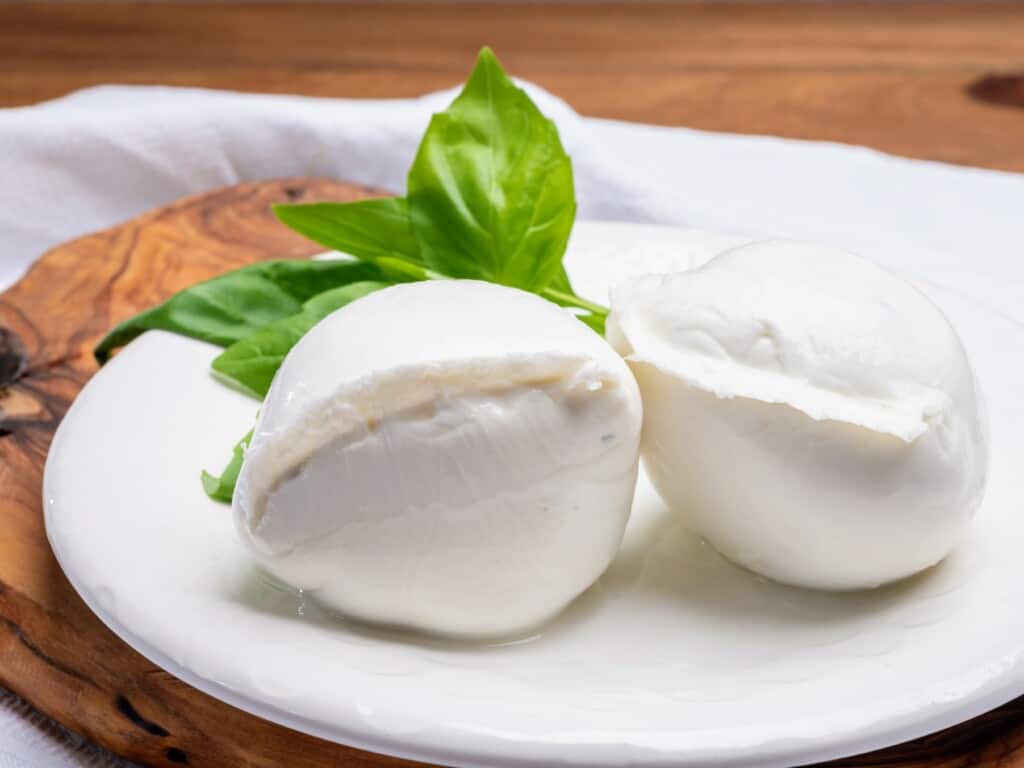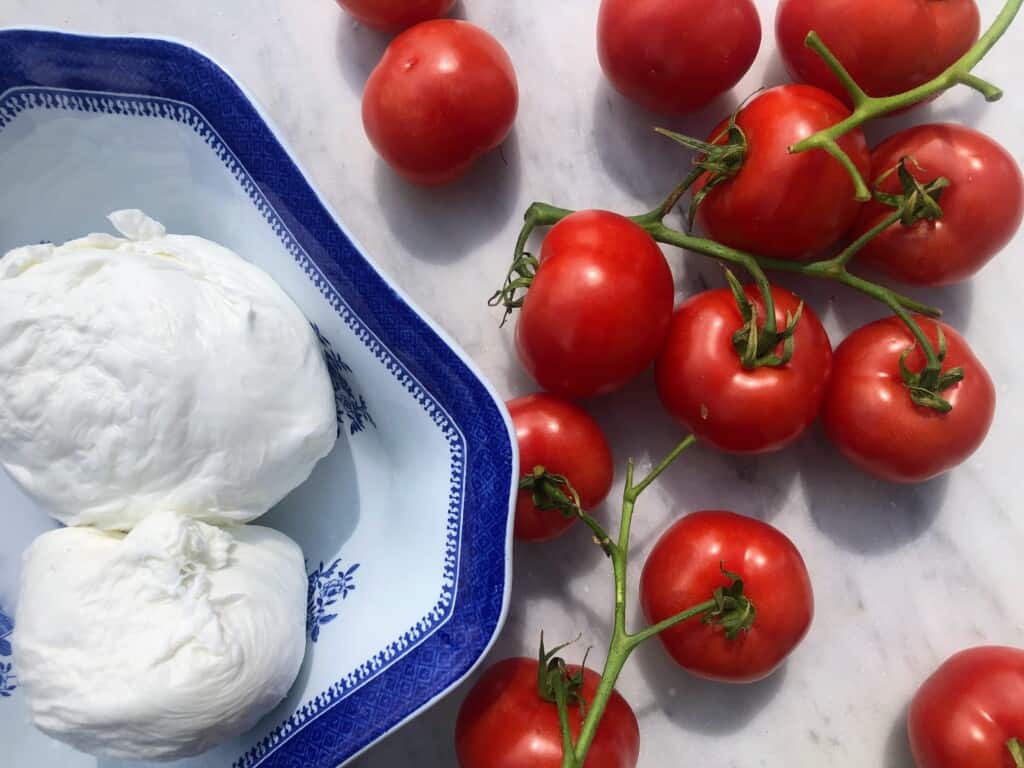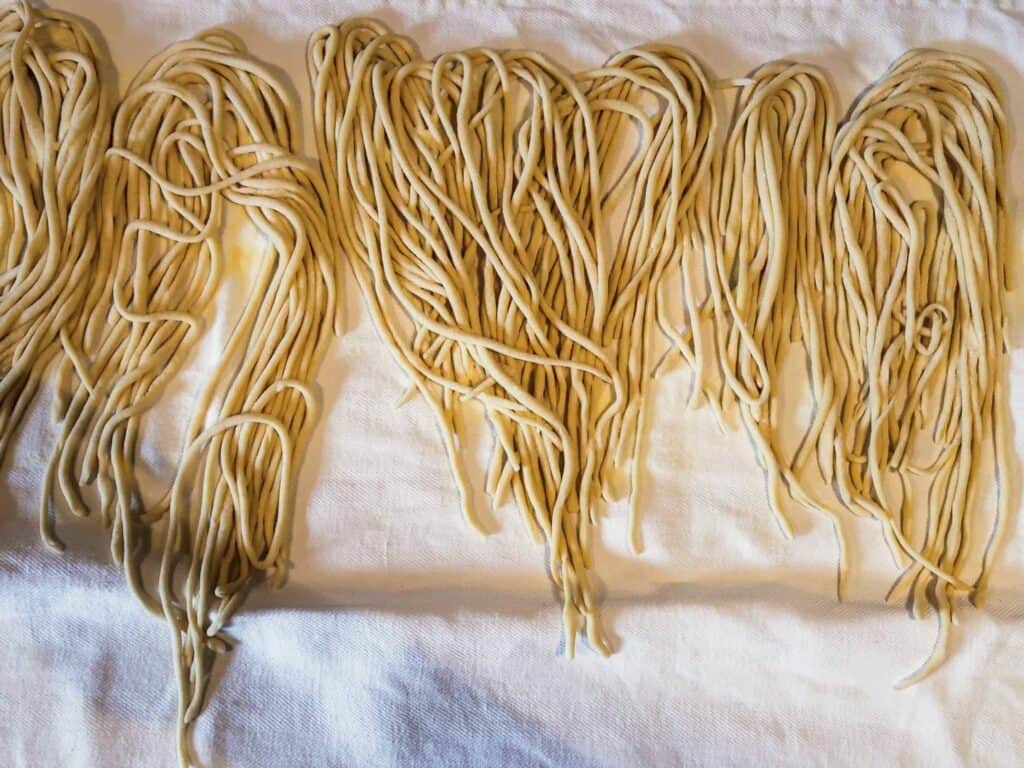Last updated on April 19th, 2024
Until I came to Italy I didn’t truly understand how complicated mozzarella was and that it could take so many different shapes (I also couldn’t really tell a good one from a bad one). I really only knew that I liked it and it tasted better in Italy. Can you relate?
Do you ever wonder why there might be such a large discrepancy in prices and could it really make that much of a difference?
Do you ever sit down to order a pizza in Italy and notice there are four different kinds of mozzarella to choose from?
Let’s go over some of the basics and finally clear the air about mozzarella types and shapes once and for all!
Jump to Section
What is Mozzarella?

The word mozzarella comes from the dialect spoken in southern Italy for the word mozza, “cut” or mozzare meaning “to cut off”, referring to the technique that is used to make this cheese.
Did You Know?: We first see the term mozzarella appear in 1570 in a cookbook but earlier descriptions of this particular cheese have been found dating back to the 12th century.
Mozzarella is traditionally made from Italian buffalo cow milk using a specific cheese-making process known as pasta filata which creates a high-moisture, soft yet slightly chewy cheese that melts oh so perfectly.

Most mozzarella was originally made to be eaten the day after it was made but they soon discovered it could be kept at room temperature in its brine for 5-7 days depending on the season (in warmer weather, for less time). Nowadays, it’s common for fresh mozzarella to last longer than a week when it is kept in its brine and refrigerated.
Mozzarella, as you probably already know, is a common ingredient in Italian recipes but it is very often eaten as is, accompanied by tomatoes and other fresh, seasonal vegetables and of course, a drizzle of olive oil!
Nice To Know: Mozzarella is a true art form that is taken very seriously in southern Italy. Italians work for months (even years!) under master mozzarella makers to learn the trade and to understand all the nuances of the different shapes and varieties.
Learn More: Study up on all types of Italian formaggio with our Complete Guide to Italian Cheese!
How is Mozzarella Made?
Whey from the last batch of mozzarella production is added to the milk which is left to work its own magic. Rennet (enzymes from the stomach of another animal and fundamental for making most cheese) is then mixed in, allowing the mixture to coagulate into a curd. The curds are then cut into small pieces and left once again to firm up even more.

After the curds have firmed up quite a bit they are cooked to separate the whey (the moisture in the curds) from the curds, which is then drained.
The next step is where the real artform lies, in the pasta filata, meaning “spun paste” in Italian. The curds are stretched by kneading the mass until the cheese maker is satisfied (and only he or she will know when the time is right!). Strands of cheese are then pulled out and torn off, forming the individual mozzarella balls that we all know and love.
The 8 Types of Mozzarella Cheese
Fior di Latte

Fior di latte, meaning “flower of the milk” in Italian is the most traditional kind of mozzarella made with cow’s milk (although technically it is not truly mozzarella as by definition it’s made with buffalo cow’s milk). It’s very mild and lighter in flavor than buffalo mozzarella.
Smoked Mozzarella /Affumicata

Smoked mozzarella is mozzarella that has gone through the entire process of fresh mozzarella but is then smoked, giving it a golden and harder exterior with a nutty, earthy flavor. After being smoked, it is sometimes dried. It is a particular flavor, not loved by all but our family loves it, even on pizza! You can find it in many shapes.
Try It: Be sure to try both fresh and aged smoked mozzarella if you like smokey foods. Smoked mozzarella is made either fresh like regular mozzarella packaged in brine or slightly dried which has a firmer consistency.
Sheep’s Milk Mozzarella
Produced in the same manner as cow’s milk mozzarella, pecorella or mozzapecora as it is known in Italian, is made with sheep’s milk cheese in Sardegna, Abruzzo, and Lazio. The taste is similar to that of pecorino, very rustic and a bit gamey but in a good way.
Mozzarella di Bufala DOP

Mozzarella di bufala “DOP” refers to the water buffalo milk from which the mozzarella is made. The “DOP” status is a kind of stamp of quality approval stating that the buffalo cows must be from the region of Campania. The buffalo milk has about twice the fat content as regular cow’s milk making for a richer, sweeter cheese that is much more complex for all those cheese connoisseurs out there. It tends to be a lot more ‘fluffy’ than other mozzarellas.
Tip: While I highly suggest ordering a pizza with mozzarella di bufala, you will notice your pizza is a bit soggier in the middle. When this cheese melts, compared to regular cow’s milk mozzarella, it lets out a lot more liquid. For me, however, the taste trumps the soggy aspect (and it also doesn’t always become soggy).
Read more about Mozzarella di Bufala!
Burrata

Burrata, meaning “buttered” in Italian, doesn’t need much more of an explanation than its Italian translation gives us. Originally from Puglia, this highly prized variety of mozzarella is essentially the scraps of cheese mixed with cream enclosed in a silky smooth casing of stretched mozzarella. When you break into it the cream center oozes out, screaming for a drizzle of olive oil and a crusty end of bread. Served like this, it’s a meal in itself!
Stracciatella

This variety of mozzarella gets its name from the Italian word straccia, meaning “shred” or “rag”. Stracciatella is made with all the leftover scraps or shreds from the mozzarella-making process (from right before the curd comes together into a solid mass). It is then mixed with cream and used as a luxurious, spreadable mozzarella.
Fun Fact: One of Italy’s most loved flavor of gelato is called stracciatella, named after the chocolate streaks or ‘rags’ that run through the fiordilatte flavor gelato.
Shredded Mozzarella / Mozzarella Block (For Pizza Base)

Also known as low-moisture mozzarella, this is the best mozzarella used to make pizza at home. Most pizzerias in Italy actually do not use this but use either regular or mozzarella di bufala.
Some of the fat is removed from the curd in the mozzarella-making process by heating it above 130 °F, making for a low-fat, low-moisture, and stringy mozzarella. It also keeps much longer in the refrigerator.
Lactose-Free

Cheeses are generally low-lactose because much of it is removed when the whey is strained from the curds, however, some does remain in the curds. To remove it, other enzymes are added which remove the naturally occurring lactose but it does further process the cheese, making it less flavorful.
The 6 Shapes of Mozzarella Cheese
Ovolini

Ovolini are basically smaller mozzarella balls about the size of an egg. They are perfect for me as I think one regular-size mozzarella is a bit too much. This being said, it won’t be enough to make a pizza with!
Bocconcini

These “little mouthfuls” are literally just that – one-bite balls of mozzarella perfect for popping into your mouth (my favorite) or tossing into salads.
Perline
Meaning “small pearls” in Italian, these little guys are the smallest of the mozzarella balls but don’t let them fool you, weighing in at just a couple of grams each they still pack a punch!
Ciliegine

This cherry-sized mozzarella ball falls between the bocconici and the perline in size.
Nodini

Nodini are ‘small knots’ in Italian and as its name suggests, this mozzarella is literally knotted into various sizes by hand when stretching it off in the final step of the cheese-making. It still remains glossy and beautifully smooth but has an elegant shape commonly enjoyed during celebrations and holidays here in Italy.
Treccia

Treccia, meaning ‘braid’ in Italian, is this mozzarella type’s shape. The cheese is stretched into long strips and then braided when it is still warm. Italians buy this for big events or holidays when they will be hosting many people. The treccia is served on a platter with a knife and fork and you are expected to slice off however much you like.
Mozzarella Types We Don’t Have in Italy
String Cheese

String cheese is an American invention that you will not find here in Italy. The texture is the same as shredded or block mozzarella because it’s also low fat and low moisture. The real difference is in how it has been shaped into long cylinders but the genetic makeup is the same. Like block mozzarella it’s not kept in brine and thus, has a long shelf life of several months.
The Best Type and Shape of Mozzarella
The Best Type of Mozzarella in Italy

When it comes to the type of mozzarella there is absolutely no question about it, mozzarella di bufala wins hands down. The flavor is so much more complex and the extra creaminess can’t be beat.
This is also reflected in the price. The mozzarella di bufala price per kilogram is almost double that of fior di latte.
Tip: Be careful not to get tricked. Sometimes mozzarella will be sold as mozzarella CON bufala but what you want is mozzarella DI bufala. Con means “with”, meaning that the mozzarella is made with both cow and buffalo milk whereas di means “of” and thus, implies made only with buffalo cow milk.
The Best Shape of Mozzarella in Italy

Every Italian has his own preference when it comes to mozzarella shape and for one main reason: the ratio of smooth, slick outside to creamy, plump, fluffy yet slightly chewy inside. I personally like the traditional ball shapes, sizes ovolini and larger.
It’s hard to say what Italians like as a whole but by simply looking at specialty mozzarella shops and grocery stores, the overwhelming majority is the traditional large ball-shaped mozzarella.
Preferred Mozzarella of Italian Children
Kids love the small bite-size mozzarella because they are fun to eat and they make prepping a bit easier as there is no cutting involved. But again, the ratio of the ‘pouch’ of the mozzarella to its contents, which differ in texture is important here. The traditional shape of the mozzarella ball, slightly smaller than a bocce ball, has just the right ratio, making it the most loved mozzarella shape.
Recipes that Use Mozzarella Cheese

- Pizza
- Lasagna
- Pasta con pomodoro fresco e mozzarella – with fresh tomato and mozzarella
- Insalata caprese – caprese salad
- Mozzarella in carrozza – deep fried grilled cheese sandwich
- Pasta al forno – baked pasta
- Parmigiana di melanzana – eggplant parmesan
- Frittata di mozzarella – mozzarella omelette
- Pasta alla sorrentina – baked pasta with tomato and mozzarella
- Mozzarelline fritte – fried mozzarella
- Insalata di farro – farro salad
- Risotto alla pizzaiola – risotto with tomato and mozzarella
- Fiori di zucchini fritti – fried zucchini flowers

Cheeses That Are Sometimes Mistaken as Mozzarella
Scamorza is Not Mozzarella

Scamorza is often mistaken as a kind of mozzarella but it is aged, setting it distinctly apart from its sister cheese.
The entire process of making scamorza is the same but the curds are cut up into smaller pieces so they retain less moisture. After the cheese has been pulled out and shaped into a tear-drop shape it is then hung and aged for about two weeks. The aging process makes for a harder cheese similar to provolone, with a nuttier taste that you can cut more easily.
Insider’s Tip: Our local mozzarella producer assures us to eat the exterior even if it is a bit tough. It’s a personal preference but it is not going to harm you.
The Blue Mozzarella Scandal
In the early 2000’s mozzarella got a bit of a bad reputation. Unfortunately, the water that many of the bufala cows were drinking and that was used in the cheese-making process was polluted, resulting in mozzarella that had a blue tint to it. It wasn’t a bright blue color but rather, a light tint, almost fluorescent, that glowed in the right light. This cheese made its way across borders where it was immediately recalled.
There have been huge efforts since to clean up the Mediterranean waters and in particular with special treatment and attention to the Southernmost part of Italy where the water was the most polluted. Fret not, this is not an issue today but it did leave a bit of a dark shadow (or blue tint!) on the mozzarella market for a couple of years.
I hope this has helped clear up any questions you had about the types and shapes of mozzarella. Now it’s time to get eating!




